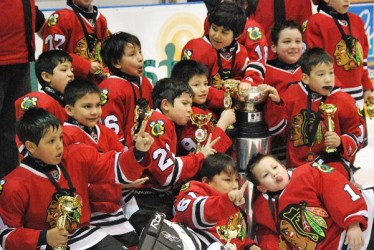Article Origin
Volume
Issue
Year
Perhaps one day organizers of the Little NHL Tournament will want to consider changing its moniker.
That’s because the event—officially the Little Native Hockey League Tournament—is not quite so little anymore.
A tournament record of 153 clubs will participate at the 42nd annual running of the event, scheduled for March 11 to 14.
That’s a far cry from the 17 squads that took part in the inaugural tournament in Little Current, Ont.
The Six Nations Minor Hockey Association (SNMHA) will host this year’s event, which traditionally attracts Aboriginal squads from all across Ontario.
But since there is only one hockey rink in Six Nations, all tournament matches will be staged in Mississauga, about a 70-minute drive away from the Aboriginal community.
“The tournament has long outgrown the small towns,” said Blaine LaForme, the president of the SNMHA.
When submitting application bids these days communities must prove they can handle the logistics of accommodating the thousands who will attend the tournament.
“They require a minimum of 4,000 (hotel) rooms with your application,” LaForme said. “Mississauga far exceeded that.”
Six Nations organizers had originally thought about having tournament contests in nearby Brantford and Hamilton.
“But (the 4,000-room stipulation) ruled that out,” LaForme said.
The Six Nations association had previously hosted this tournament in 1997. A total of 86 teams took part in that event, which saw games staged in Brantford.
This year’s tourney will feature about 3,600 participants, which includes players and bench staff.
LaForme is unsure how many people will attend the tournament. But he anticipates each participant will bring a minimum of one person with them, resulting in more than 7,000 people.
A previous tournament high of 125 teams competed at last year’s event staged in Sudbury. LaForme was somewhat skeptical the 2013 tourney would be as successful.
“It’s typically a northern (Ontario) tournament,” he said. “The vast majority of teams are from the north. So I’m very surprised. I would have been happy with 125-130 teams.”
Marvin Assinewai, the president of the Little NHL, said despite a record number of participating clubs last year, the 2012 tournament could have been even bigger.
“One of the reasons they weren’t coming last year was because all of the (hotel) rooms were full,” he said, adding some of the teams ended up staying in hotels in North Bay, about a 90-minute drive from Sudbury.
It’s unlikely, however, there will be many complaints about the proximity of accommodations this year.
Most of the hotel rooms where participants will stay are mere minutes from the rinks where matches will be staged.
The tournament headquarters will be the Hershey Centre, which is the home rink for the Ontario Hockey League’s Mississauga Steelheads. This facility has a main bowl arena, with seating for more than 5,000 as well as three adjacent rinks.
Games will also be held at Iceland Arena and Meadowvale 4 Rinks, which have four pads apiece.
LaForme was not anticipating being as busy as he has been. His phone has been ringing constantly from people asking questions about things to do and see in Mississauga and Toronto, the country’s largest city which is about 20 minutes away.
“They all want to see as much as they can,” LaForme said of those individuals who will be travelling to this part of southern Ontario, perhaps for the first time. “For some people this might be the one and only time they ever come here.”
As in previous years, tournament participants are anxiously anticipating the event.
“Probably about 80 per cent of them play some sort of organized hockey,” LaForme said. “Some of them though just play pond hockey. And for a lot of them this tournament is the highlight of the year.”
The 2013 tourney will feature 10 divisions, six male and four female. The boys’ divisions are for those at the tyke, novice, atom, peewee, bantam and midget groupings. Girls will compete in atom, peewee, bantam and midget divisions.
The host Six Nations association will be represented by 12 teams. Half of those entrants will be in the boys’ atom and peewee categories as Six Nations will have three clubs in both of these groupings.
Six Nations will also have two boys’ squads participating in the bantam division and one each in the tyke and midget categories.
Six Nations will also have two girls’ teams taking part. They will be in the atom and bantam divisions.
- 5591 views

